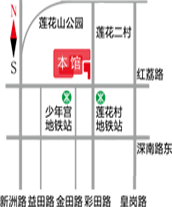
- Come and watch a design feast
-
Article source: Shenzhen Business Daily, October 12, 2009
This is a feast of design, as well as a surge of thinking and creativity. On October 11th, the grand curtain of the 11th National Art Exhibition · Art and Design Exhibition officially opened at the two major art museums in Shenzhen - Guan Shanyue Art Museum and Hua · Art Museum. The exhibition will continue until October 29th. This year's National Art Exhibition Design Exhibition is another time held in Shenzhen since the opening of the 9th National Art Exhibition Design Exhibition. The posters that strike people's hearts, the environmental design that changes the city, the industrial products closely related to social life, and the clothing that affects future trends all demonstrate the explosive development of design.
Shenzhen design has achieved impressive results
This design exhibition consists of four design categories: clothing, graphic design, environmental art, and industry. Currently, 463 selected works are exhibited at the Guan Shan Yue Art Museum and the Hua · Art Museum, with 3328 works from across the country. It is reported that the majority of participants in this year's exhibition are still teachers and students from art schools, but the number of professional designers in the industry has significantly increased compared to the previous year, and the composition of the judges also fully considers industry factors. Except for environmental art works, all display forms are presented in physical form, and a considerable number of product designs have recently been put into mass production.
As the "city of design", Shenzhen's ability to host a national art and design exhibition again after 10 years is widely regarded. The organizers and judges have given evaluations that Shenzhen's strength is not only reflected in the number of selected works, but also in its comprehensive ability to organize and operate large-scale design exhibitions. Shenzhen designers have achieved impressive results in the fields of clothing, graphic design, environmental arts, and industry. Among the shortlisted works, Shenzhen has 57, accounting for approximately 12% of the total. In addition, Shenzhen has a total of 15 nominated works for awards, including 1 gold nominated work (Zhang Lichuan's clothing design work "A Midsummer Night's Dream"), 2 silver nominated works (including Shenzhen Yanwen Design Co., Ltd.'s graphic design work "The 6th International Ink Biennale Series" and Wang Yuefei and others' graphic design work "The mascot of the 26th Shenzhen World University Games"), 1 bronze nominated work (Huang Yongjie's environmental art design work "Folk Museum"), and 2 excellent nominated works (Zhang Dali's graphic design work "Graphic Design in China" and Liu Jun's clothing art design "Ink").
In the 1980s and 1990s, Shenzhen, relying on its proximity to Hong Kong and Macau, collaborated with designers from Hong Kong, Macau, and Taiwan to promote the development of modern design in mainland China. For this purpose, the organizing committee specially arranged the "Ronghui - Shenzhen Hong Kong Design Works Invitation Exhibition" as a peripheral exhibition of the 11th Art and Design Exhibition, to be held simultaneously in the exhibition hall on the third floor of the Guanshan Yue Art Museum.
Design is closely related to life
Entering the exhibition hall of the Guan Shan Yue Art Museum, we met the T-stage head-on and saw various creative clothing worn by the models. The starting piece is a navy blue gauze dress with a Western formal dress design, adorned with bright rose colors and traditional embroidery to depict details. Simple yet gentle yet firm. This is the work "A Midsummer Night's Dream" by Zhang Lichuan, a young teacher at Shenzhen University.
If it weren't for professionals, it would be difficult to distinguish the superiority and inferiority of fabrics and craftsmanship from the clothes worn on them. They come in different forms and creative ideas, but they don't feel distant, just like clothes that can also be worn in our daily lives. Wu Hong, Deputy Director of the Clothing and Art Committee of the China Artists Association and Vice Dean of the School of Art and Design at Shenzhen University, told reporters that the selection criteria for the past two design exhibitions were based on an aesthetic perspective, viewing clothing from the perspective of artists, and more attention was paid to the decorative properties of fabrics and clothing. This year, from the perspective of design specialization, all shortlisted works are required to have the attributes of clothing itself. Previously, non functional "clothing" similar to installation art were excluded; At the same time, it is required to have cultural and fashionable connotations, which can guide the market for future clothing trends. For the nominated works, Wu Hong's view is that they have fashion foresight and are an organic combination of Chinese culture and clothing elements. In one sentence, integrating ancient and modern Chinese and Western cultures, showcasing the spirit of the times.
The design exhibition works are divided into four exhibition halls at the Guanshan Yue Art Museum. The front hall is designed for clothing and clothing, while the back hall includes a comprehensive design of posters and packaging. The two wings are designed for book binding. Each exhibition hall has a white background board, which distinguishes them by colored patterns in addition to indicating the category of works in each exhibition hall. According to Bi Xuefeng, the exhibition designer and chairman of the Shenzhen Graphic Design Association, this is the use of lines and frames to construct objects in daily life, such as mobile phones, jewelry, desk lamps, tables and chairs, small houses, etc., in order to reveal the relationship between design and life. In the clothing design area, red dots are used to refer to patterns related to diamonds and ties, while in industrial design, blue item patterns are used. In environmental design, green is used to refer to buildings, tables and chairs, etc.
The close relationship between design and life is more vividly reflected in the industrial products and environmental design displayed at the Hua · Art Museum. The All Terrain Assault Rescue Vehicle, collectively designed by students from Sichuan Academy of Fine Arts, combines the functional characteristics of medical rescue and engineering machinery, and looks like a multi-functional rescue vehicle that looks a bit like a tank; A dual-purpose flood relief tent called "Noah Boat" can be used for both temporary residence and emergency rescue. Some national key projects are closely related to society, cities, and daily life, such as the interior design of the Beijing Olympics rail transit, the renovation of Qianmen Street in Beijing, the design of key halls of the National Museum, the "Water Rice Field" project of Shenyang Jianzhu University campus landscape, and the red ribbon in the green forest of Tanghe Park in Qinhuangdao.
In addition to these large-scale works with a certain weight, lightweight small objects also attract people's attention, such as shell shaped pet toilets that can be folded and carried in pockets; Portable storage style tables and chairs, inspired by the creative roots of traditional Chinese umbrellas; Slippers that can distinguish between front and back feet
Behind each piece of work, creativity surges
In graphic design works, posters have become a dominant category. The most striking feature is the "I Have an Ideal" series of posters that reflect the 5.12 earthquake. This is a group of hand drawn portraits of earthquake orphans, with a very clean and refreshing scene. Six children, some holding their cheeks, some pursing their mouths, some bowing, some clenching their fists, some raising their hands to speak, some applying cotton wool on their heads, some bandaged their eyes, and their white clothes depict their respective ideals in different characters. Some want to become scientists and "create a time and space shuttle to save my mother"; Some want to become astronauts, "if an earthquake comes, take people to outer space"; Some want to become heroes when they grow up, "helping people in need like the People's Liberation Army."; Some want to become geologists, "measuring which year and month there is an earthquake"
This is the ideal of children, and it is also a new sprout that sprouts from the young hearts of those who suffer from disasters, pain, and death. Reading it carefully, observing it, and savoring it, one cannot help but be moved by thoughts and emotions. There are many works that allow people to appreciate the power and function of posters. A piece of work called "Soul in the Narration of Characters", the entire picture is like a template of font, with a shark dripping blood from the corners of its mouth. The prompt below reads: Don't let our children only see today's animals in the text.
In book binding design exhibits, there are both traditional forms and conceptual works in terms of content and form. A book called "Zuo" is a collection of various chairs and chairs; The "Hundred Family Surnames" that stands up is a device of a book, and its structure is quite novel; The experimental approach of the Four Books and Five Classics with a folded corner; "Mud and Mud Dog Chronicle" is a wooden box made of clay on the cover, which includes various small objects carrying childhood memories in addition to the picture album... The Shenzhen Graphic Design Association's "Yearbook" from 2008 to 2009 is also included in it, with a design resembling a traffic warning symbol and a yellow zebra crossing as the cover, which is meaningful.



